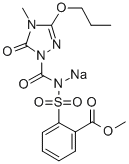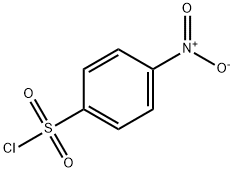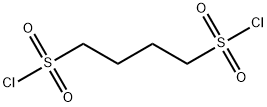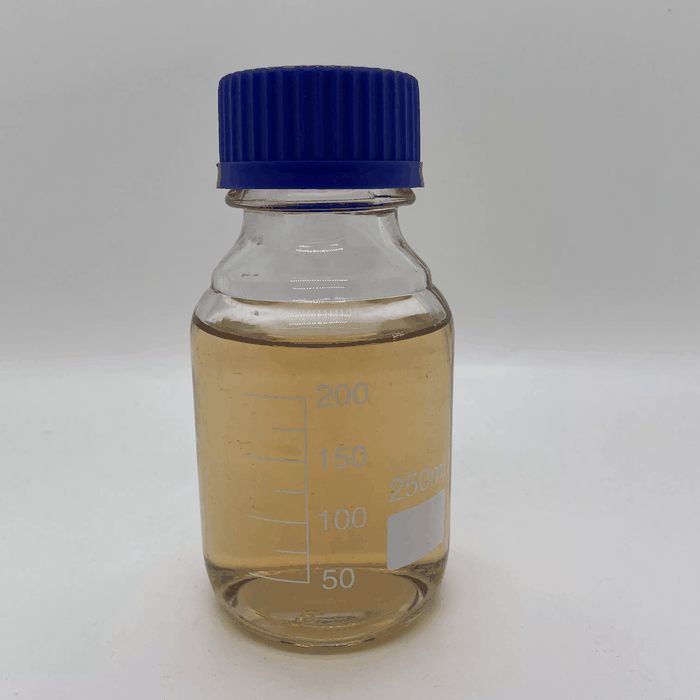1-Propanesulfonyl chloride
- CAS NO.:10147-36-1
- Empirical Formula: C3H7ClO2S
- Molecular Weight: 142.6
- MDL number: MFCD00007462
- EINECS: 233-414-7
- SAFETY DATA SHEET (SDS)
- Update Date: 2024-12-18 14:15:30

What is 1-Propanesulfonyl chloride ?
Chemical properties
Light yellow liquid
The Uses of 1-Propanesulfonyl chloride
1-Propanesulfonyl chloride was used in synthesis of 1-alkyl-3-methylimidazolium alkanesulfonate ionic liquids.
Synthesis
2,4,6-Trichloro-[1,3,5]-triazine (TCT) was added at room temperature to a solution of propane-1-sulfonic acid in acetone dry, followed by NEt3 dropwise. The resulting mixture was irradiated to 80 °C (50 W of MW power) for 20 min in a sealed tube (10 mL pressure-rated reaction vial) in a self-tuning single-mode irradiating synthesizer. The mixture was cooled rapidly to room temperature by passing compressed air through the microwave cavity for 1 min. After cooling to room temperature, the precipitate was filtered off on Celite to afford 1-Propanesulfonyl chloride[1].
References
[1] Lidia De Luca, Giampaolo Giacomelli. “An Easy Microwave-Assisted Synthesis of Sulfonamides Directly from Sulfonic Acids.” The Journal of Organic Chemistry 73 10 (2008): 3967–3969.
Properties of 1-Propanesulfonyl chloride
| Melting point: | -37 °C |
| Boiling point: | 78-79 °C/15 mmHg (lit.) |
| Density | 1.267 g/mL at 25 °C (lit.) |
| vapor density | 4.9 (vs air) |
| refractive index | n |
| Flash point: | 176 °F |
| storage temp. | under inert gas (nitrogen or Argon) at 2-8°C |
| form | clear liquid |
| color | Colorless to Light yellow |
| Water Solubility | Decomposes in hot water. |
| Sensitive | Moisture Sensitive |
| BRN | 1747500 |
| CAS DataBase Reference | 10147-36-1(CAS DataBase Reference) |
| NIST Chemistry Reference | 1-Propanesulfonyl chloride(10147-36-1) |
| EPA Substance Registry System | 1-Propanesulfonyl chloride (10147-36-1) |
Safety information for 1-Propanesulfonyl chloride
| Signal word | Danger |
| Pictogram(s) |
 Corrosion Corrosives GHS05 |
| GHS Hazard Statements |
H314:Skin corrosion/irritation |
| Precautionary Statement Codes |
P280:Wear protective gloves/protective clothing/eye protection/face protection. P363:Wash contaminated clothing before reuse. P303+P361+P353:IF ON SKIN (or hair): Remove/Take off Immediately all contaminated clothing. Rinse SKIN with water/shower. P305+P351+P338:IF IN EYES: Rinse cautiously with water for several minutes. Remove contact lenses, if present and easy to do. Continuerinsing. P337+P313:IF eye irritation persists: Get medical advice/attention. |
Computed Descriptors for 1-Propanesulfonyl chloride
1-Propanesulfonyl chloride manufacturer
New Products
(S)-3-Aminobutanenitrile hydrochloride 4-Methylphenylacetic acid N-Boc-D-alaninol N-BOC-D/L-ALANINOL Tert-butyl bis(2-chloroethyl)carbamate 3-Morpholino-1-(4-nitrophenyl)-5,6-dihydropyridin- 2(1H)-one Furan-2,5-Dicarboxylic Acid Tropic acid 1-Bromo-3,5-Di-Tert-Butylbenzene S-2-CHLORO PROPIONIC ACID ETHYL ISOCYANOACETATE 2-Bromo-1,3-Bis(Dimethylamino)Trimethinium Hexafluorophosphate 4-IODO BENZOIC ACID 3-NITRO-2-METHYL ANILINE 1-(2,4-DICHLOROPHENYL) ETHANAMINE (2-Hydroxyphenyl)acetonitrile 4-Bromopyrazole 2-(Cyanocyclohexyl)acetic acid 4-methoxy-3,5-dinitropyridine 1-(4-(aminomethyl)benzyl)urea hydrochloride 2-aminopropyl benzoate hydrochloride diethyl 2-(2-((tertbutoxycarbonyl)amino) ethyl)malonate tert-butyl 4- (ureidomethyl)benzylcarbamate Ethyl-2-chloro((4-methoxyphenyl)hydrazono)acetateRelated products of tetrahydrofuran








You may like
-
 10147-36-1 Propane-1-sulfonyl chloride 98%View Details
10147-36-1 Propane-1-sulfonyl chloride 98%View Details
10147-36-1 -
 10147-36-1 98%View Details
10147-36-1 98%View Details
10147-36-1 -
 Propanesulfonyl chloride 98% (GC) CAS 10147-36-1View Details
Propanesulfonyl chloride 98% (GC) CAS 10147-36-1View Details
10147-36-1 -
 1-Propanesulfonyl Chloride CAS 10147-36-1View Details
1-Propanesulfonyl Chloride CAS 10147-36-1View Details
10147-36-1 -
 1-Propanesulfonyl Chloride CASView Details
1-Propanesulfonyl Chloride CASView Details -
 1-Propanesulfonyl chloride CAS 10147-36-1View Details
1-Propanesulfonyl chloride CAS 10147-36-1View Details
10147-36-1 -
 14714-50-2 (2-Hydroxyphenyl)acetonitrile 98+View Details
14714-50-2 (2-Hydroxyphenyl)acetonitrile 98+View Details
14714-50-2 -
 118753-70-1 98+View Details
118753-70-1 98+View Details
118753-70-1